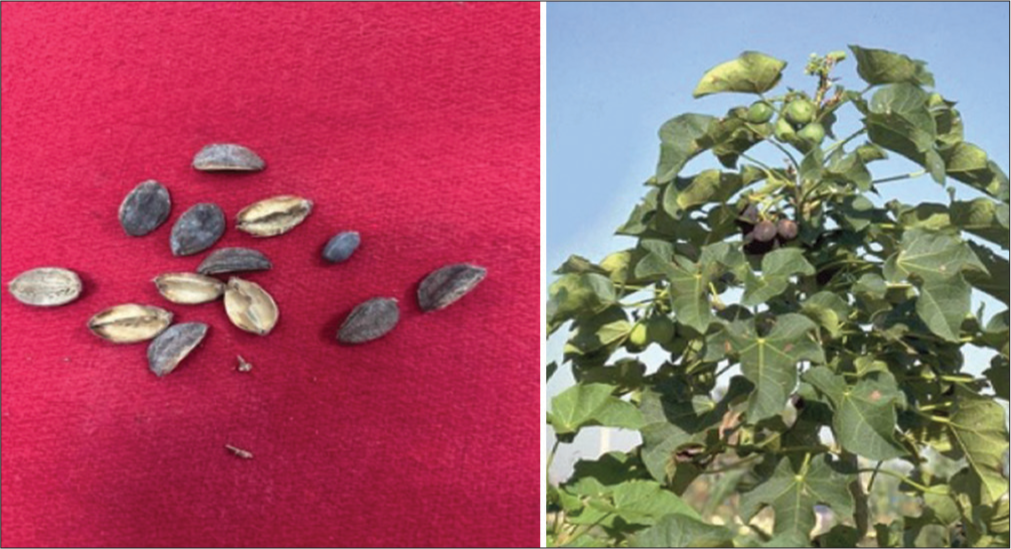Translate this page into:
Acute poisoning with Jatropha curcas in North Eastern Himalayan region – A case series and review of literature

*Corresponding author: Ankit Kumar, Department of Medicine, Military Hospital Shimla, Shimla, Himachal Pradesh, India. ankit1992afmc@gmail.com
-
Received: ,
Accepted: ,
How to cite this article: Sharma D, Pushkar K, Sharma VB, Kumar A. Acute poisoning with Jatropha curcas in soldiers posted in North Eastern Himalayan region – A case series and review of literature. Med India. 2024;3:90-3. doi: 10.25259/MEDINDIA_8_2024
Abstract
Plant poisoning is one of the common accidental sources of poisoning amongst the villagers and the troops going on long-range patrolling. Seeds of Jatropha curcas a/k/a biodiesel pant mimicking nuts are an uncommon source of poisoning, manifesting as mainly gastrointestinal symptoms and less frequently the other systemic manifestations. Here, we report a case series of two cases of serving soldiers who presented with gastrointestinal symptoms after consumption of seeds of unknown plants mimicking nuts, which was later identified as J. curcas. Both patients had favorable outcomes with syndromic management of the unknown poisoning.
Keywords
Jatropha curcas
Poisoning
Plant poisoning
Biodiesel plant
Gastrointestinal symptoms
INTRODUCTION
Plant poisoning accounts for 1.7% of all poisonous exposure in India, but most cases are mild in nature.[1] Accidental poisoning by poisonous plants is by mistaken identity with edible plants.[1] Acute poisoning with unknown substances, which includes poisonous plants, is an important cause of morbidity and mortality especially in soldiers posted in field areas and going on long-range patrolling (LRP) and children.[2]
Jatropha curcas, also known as biodiesel plant [Figure 1], is a noxious weed commonly found throughout India, especially in the southern and northeastern parts.[3] Different parts of this plant are poisonous, such as the fruit, seeds, leaf, bark, and latex. Seeds have the maximum toxicity. Jatropha poisoning is uncommonly reported, and there is no case report of poisoning by this plant in serving soldiers going for LRPs due to a lack of awareness.[4] Here, we report two cases of unknown plant poisoning that were later identified to be due to the seeds of the “Jatropha” plant, which were accidentally consumed by both soldiers by mistake.

- The seeds and plant of Jatropha curcas.
SUMMARY OF CASES
Characteristics of the patients
We had a series of two young serving soldiers presenting to the emergency department of a secondary care hospital in northeastern Himalaya with sudden onset of crampy abdominal pain, multiple episodes of vomiting, and small bowel type of diarrhea with an alleged history of consuming an unknown number of black-colored seeds from a familiar looking plant likely nut after 30–60 min of ingestion. Clinically, the first patient had severe gastrointestinal (GI) symptoms with severe dehydration with hypovolemic shock (blood pressure – 80/40 mmHg), while the second patient had mild GI symptoms without shock. Both patients had mild leukocytosis, and both had good responses to fluid resuscitation. There was no other system involvement, any organ damage, or delayed features of systemic involvement. The clinical characteristics of the cases in depicted in Table 1 and the pattern of investigation is shown in Table 2.
| S. No. | Clinical Character | Case 1 | Case 2 |
|---|---|---|---|
| 1. | Age (years) | 25 | 35 |
| 2. | Symptoms Crampy abdominal pain Number of episodes of vomiting Onset of symptoms since consumption of seeds Amount of seeds consumed Frequency of profuse water diarrhea Blood in the stool Neurological symptoms Respiratory symptoms |
Yes (Severe) 10-20 episodes 30 Mins 10 10-12 No No No |
Yes (Moderate) 2 episodes 60 Mins 04 Negative No No No |
| 3. | Signs Tachycardia Hypotension and shock Dehydration |
Yes Yes Severe |
Yes No Mild |
| 4. | Management outcomes Response to fluid resuscitation Requirement of ionotropic support Time to resolution of dehydration Delayed feature of intoxication |
Yes No 48 Hrs No |
Yes No 8 Hrs No |
Bold indicates positive values
| Investigation | Date | Date | Date | |||
|---|---|---|---|---|---|---|
| 11/01/24 (On admission- Day 1) |
12/01/24 (Day -2) |
30/01/24 (Follow up visit on Day 10) |
||||
| Case 1 | Case 2 | Case 1 | Case 2 | Case 1 | Case 2 | |
| Hb (mg/dL) | 17.2 | 18.6 | 15.1 | 16.9 | 15.7 | 16.2 |
| TLC (/cumm) | 17600 | 11700 | 6700 | 6000 | 7300 | 4900 |
| DLC-P/L/M/E (%) | 73/19/6/2 | 79/11/7/3 | 79/14/6/1 | 53/27/9/11 | 82/11/6/1 | 55/35/8/2 |
| PLT (Lakh/cumm) | 1.54 | 2.04 | 1.28 | 1.57 | 1.65 | 1.66 |
| Sugar (R) (mg/dl) | 86 | 104 | 185 | 81 | 102 | 136 |
| Urea/Creat (mg/dl) | 34/1.3 | 34/1.4 | 37/1.0 | 30/1.0 | 37/1.0 | - |
| S.Bil/AST/ALT 9 mg/dl) | 1.0/31/19 | 1.9/37/23 | 0.8/27/20 | 1.5/20/25 | 1.0/37/34 | - |
| Na+/K+ (mEq/L) | 139/4.0 | 138/3.9 | 141/3.8 | 139/3.8 | 141/3.8 | - |
| Ca2+ (mg/dL) | 9.8 | 9.3 | - | - | - | |
| Urine RE/ME | NAD | NAD | - | - | NAD | NAD |
| Stool for occult blood | Positive | Negative | - | - | Negative | Negative |
| Albumin/Glob (mg/dL) | 4.3/3.2 | 4.4/3.2 | - | - | 3.8 | 4.2/3.1 |
| PT/INR | 13.8/15.4/1.11 | 13.8/15.1/1.08 | - | 13.8/14.6/1.04 | 13.8/14.2/1.02 | |
| HIV I&II/HBsAg/VDRL | Negative | Negative | _ | |||
| ECG | Normal | Normal | ||||
| CXR PA view | Normal | Normal | ||||
| USG Abdo (DT-18/01/24) | Normal | Normal | _ | |||
Bold indicates positive values
Management and outcome
Detailed history revealed that the severity of symptoms corresponded to the number of seeds consumed. The plant could not be identified by the description given by the patients, so the unit personnel were immediately sent to the site where they consumed it to bring the seeds and leaves for identification [Figure 1]. The expertise of the toxicology center at CMC Vellore was sought, and the plant was identified as Jatropha curcas. Both patients received management as per the protocol of unknown poisoning: Removal or neutralization of toxins and symptomatic and supportive treatment and underwent gastric lavage.[5] Both patients responded well to the fluid resuscitation and other supportive measures. An important aspect of the management of unknown poisoning is looking for evidence of organ or system damage/dysfunction which was not there in both cases.
Case 1 showed a mildly raised total leukocyte count with neutrophilic leukocytosis and low platelets [Table 2] with positive stool for occult blood, which was not there in case 2. The symptoms of the second patient with mild dehydration which resolved within 8–10 h of admission, whereas the first patient with severe dehydration required 48 h of intensive care unit care and became asymptomatic after 4 days. Cases were observed for delayed/residual toxicity for 10 days, which was not there in both cases.
DISCUSSION
J. curcas has many medicinal properties and is used in alternative medical practices for ailments such as constipation, abdominal cramps/colic, skin diseases, as well as an abortifacient.[6] J. curcas seeds resemble castor seeds in shape and are black in color. The seeds are most commonly ingested as they are often mistaken for edible nuts, which were mistaken by both the soldiers in the present case, which led to accidental poisoning. The active ingredients are curcin, ricin, and cyanic acid. Curcin is a toxalbumin. It inhibits 60s ribosomal subunit, and causes hepatotoxicity and gastroenteritis. Ricin is a toxic glycoprotein, and it causes acute cell death by inactivating ribosomal ribonucleic acid and leads to hemorrhagic necrosis of several organs. The purgative effect of the plant is primarily due to diterpenoids and curcanoleic acid that are found in the in the seed oil.
J. curcas toxic manifested in the form of its GI, cardiotoxic, and hemolytic system involvement. Abdominal pain, diarrhea, vomiting, and nausea are the most common GI manifestations which were present in both of our cases.[4] The combination of diarrhea and vomiting in the presence of pupillary constriction can be confused with organophosphate poisoning.[7] Measurement of plasma acetylcholinesterase activity level, which is normal after Jatropha ingestion and decreased following organophosphate poisoning, may help differentiate between the two. None of the cases presented with cholinergic signs or symptoms such as miosis, excessive salivation, lacrimation, or sweating.[7] The ricin toxin mainly causes cardiotoxic effects such as tachycardia, hypotension, peripheral circulatory collapse, and electrocardiographic changes.[2] Hepatic and renal dysfunction, as well hemolytic changes, including agglutination of red blood cells, has been reported.[2] None of these were noted in our patients.
CONCLUSION
Poisoning with unknown substances and/or plants is common in combatants, especially during LRP’s and field areas. The common manifestation of the Jatropha poisoning is mainly the GI manifestation and dehydration depending on the amount of consumption of seeds, which requires aggressive fluid resuscitation depending on the severity of dehydration. Hence, there is a strong felt need to create awareness about the detrimental effects of such poisonous plants and to sensitize and educate troops about them, which will prevent loss of life and unnecessary morbidity.
What have we learnt?
Jatropha poisoning is a well-reported poisoning which can be prevented by the creation of more awareness among troops and physicians for initiation of timely management.
The most common symptoms are GI (vomiting, diarrhea, and abdominal pain), which may progress to involve the liver and kidney.
The toxic effects of the plant are due to the ricin component in the seeds and appear to be directly proportional to the number of seeds consumed.
A syndromic approach to the unknown poison is very important for a good outcome.
Author contributions
DS, MD: Concept, design, literature search, data acqisition, data analysis, manuscript preperation and editing. KP, MD: Concepts, definition of intellectual concepts, statistical analysis. VBS, DM: Design, literature search, manuscript editing and review. AK, MD (Corresponding author): literature search, manuscript editing and review, submission and correspondence.
Ethical approval
The Institutional Review Board approval is not required.
Declaration of patient consent
The authors certify that they have obtained all appropriate patient consent.
Conflicts of interest
There are no conflicts of interest.
Use of artificial intelligence (AI)-assisted technology for manuscript preparation
The authors confirm that there was no use of artificial intelligence (AI)-assisted technology for assisting in the writing or editing of the manuscript and no images were manipulated using AI.
Financial support and sponsorship
Nil.
References
- Plant poisoning-an observational study in a Tristate region emergency department. Int J Med Sci Public Health. 2016;5:2158.
- [CrossRef] [Google Scholar]
- Jatropha poisoning in children. Med J Armed Forces India. 2010;66:80-1.
- [CrossRef] [PubMed] [Google Scholar]
- Biodiesel and hydrogen production in a combined palm and Jatropha biomass biorefinery: Simulation, techno-economic, and environmental evaluation. ACS Omega. 2020;5:7074-84.
- [CrossRef] [PubMed] [Google Scholar]
- Acute accidental mass poisoning by Jatropha curcas in Agra, North India. Egypt J Forensic Sci. 2016;6:496-500.
- [CrossRef] [Google Scholar]
- Acute poisoning: Understanding 90% of cases in a nutshell. Postgrad Med J. 2005;81:204-16.
- [CrossRef] [PubMed] [Google Scholar]
- Safety of hydrothermally treated kernels from edible Jatropha curcas L. (Chuta) as a novel food pursuant to Regulation (EU) 2015/2283. EFSA J. 2022;20:6998.
- [CrossRef] [PubMed] [Google Scholar]
- A case of Jatropha multifida poisoning resembling organophosphate intoxication. Clin Toxicol 206;. ;44:337-8.
- [CrossRef] [PubMed] [Google Scholar]






